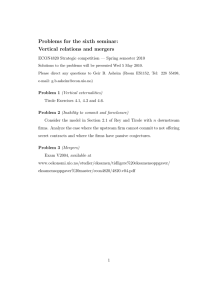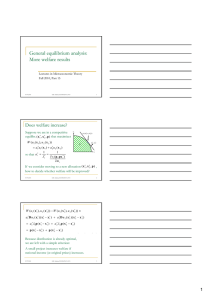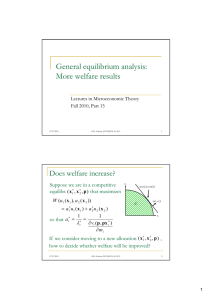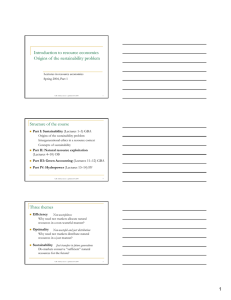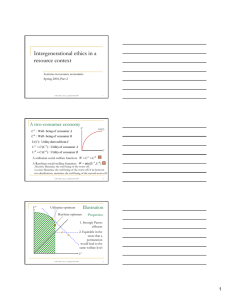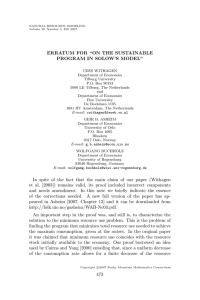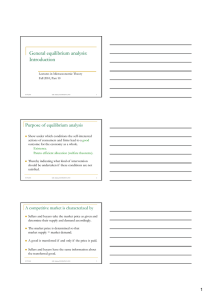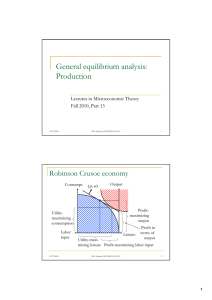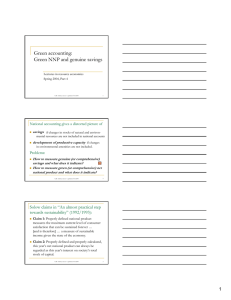Green accounting: (i) Welfare results (ii) Open economies
advertisement
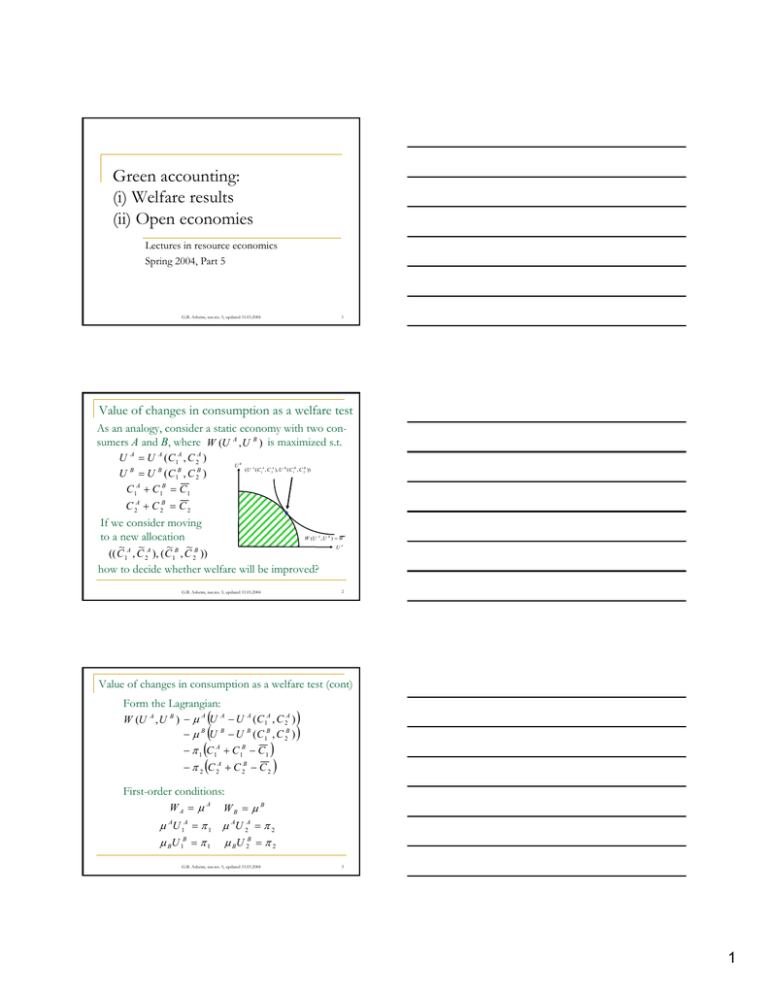
Green accounting:
(i) Welfare results
(ii) Open economies
Lectures in resource economics
Spring 2004, Part 5
G.B. Asheim, nat.res. 5, updated 31.03.2004
1
Value of changes in consumption as a welfare test
As an analogy, consider a static economy with two consumers A and B, where W (U A , U B ) is maximized s.t.
= U A (C 1A , C 2A )
= U B (C 1B , C 2B )
A
C 1 + C 1B = C 1
U
U
A
B
UB
(U A (C 1A , C 2A ), U B ( C 1B , C 2B ))
C 2A + C 2B = C 2
If we consider moving
to a new allocation
W (U A , U B ) = W
~ ~
~ ~
(( C 1A , C 2A ), ( C 1B , C 2B ))
UA
how to decide whether welfare will be improved?
G.B. Asheim, nat.res. 5, updated 31.03.2004
2
Value of changes in consumption as a welfare test (cont)
Form the Lagrangian:
W (U A , U B ) − µ A (U A − U A ( C 1A , C 2A ) )
− µ B (U B − U B ( C 1B , C 2B ) )
− π 1 (C 1A + C 1B − C 1 )
− π 2 (C 2A + C 2B − C 2 )
First-order conditions:
WA = µ A WB = µ B
µ AU 1A = π 1 µ AU 2A = π 2
µ BU 1B = π 1 µ BU 2B = π 2
G.B. Asheim, nat.res. 5, updated 31.03.2004
3
1
Value of changes in consumption as a welfare test (cont)
~ ~
~ ~
W (U A ( C 1A , C 2A ), U B ( C 1B , C 2B ))
− W (U A ( C 1A , C 2A ), U B ( C 1B , C 2B ))
~A
~
A
≈ W A ⋅ U 1 ⋅ ( C 1 − C 1A ) + W A ⋅ U 2A ⋅ ( C 2A − C 2A )
~
~
+ W B ⋅ U 1B ⋅ ( C 1B − C 1B ) + W B ⋅ U 2B ⋅ ( C 2B − C 2B )
~A
~A
A
A
= π 1 ⋅ (C1 − C1 ) + π 2 ⋅ (C 2 − C 2 )
~
~
+ π 1 ⋅ ( C 1B − C 1B ) + π 2 ⋅ ( C 2B − C 2B )
~
~
= π 1 ⋅ (C 1 − C1 ) + π 2 ⋅ (C 2 − C 2 ) = π 1 ⋅ ∆ C1 + π 2 ⋅ ∆ C 2
(π 1 , π 2 ) corresponds to market prices in a comp. eq.
Welfare impr. iff pos. value of changes in consumption.
4
G.B. Asheim, nat.res. 5, updated 31.03.2004
Value of changes in consumption as a
welfare test in a dynamic economy
Turn now to a dynamic economy with a continuum of
consumers. In analogy, if welfare is maximized, then welfare improvement is measured by the present
− i dτ
∞
value of future changes in consumption: ∫0 C& t e ∫ dt
t
0
Since K& 0 − p0 R0 =
∞
∫0
(
t
τ
)
− iτ dτ
C& t e ∫0 dt and Y&0 = i0 K& 0 − p0 R0 :
Observation: Welfare improvement is indicated by
non-negative genuine savings and growth in Green
NNP. This holds under comprehensive accounting.
(G.B. Asheim and M.L. Weitzman, Does NNP growth indicate welfare improvement? Econ Letters, 2001)
5
G.B. Asheim, nat.res. 5, updated 31.03.2004
Can wealth
indicate welfare?
∞
∞
t
W&0 = ∫ C& t e ∫0
∞
t
W0 = ∫ Ct e ∫0 dt
{
0
Genuine
1
4243
wealth
− iτ dτ
Present value of
future consumption
t
dt + ∫ (i0 − it )Ct e ∫0 dt
A decreasing
0
interest rate leads to capital
gains not corresponding to
In the D-H-S model with
welfare improvement.
constant returns to scale:
− iτ dτ
− iτ dτ
0
W0 = K 0 + p0 S 0
A decreasing interest rate is
W&0 = K& 0 + p0 S&0 + p& 0 S 0
reflected by capital gains on
= K& 0 − p0 R0 + i0 p0 S 0 by Hotelling’s rule the resource.
> K& − p R which indicates welfare improvement
0
0
0
G.B. Asheim, nat.res. 5, updated 31.03.2004
6
2
Hartwick’s rule in open economies: Should
resource-rich countries reinvest resource rents?
k&t + K& t = Q(kt + K t , rt + Rt ) − ct − Ct
D-H-S model
with 2 countries
S&t = − Rt
s&t = −rt
∞
∞
s0 = ∫ rt dt
S 0 = ∫ Rt dt
0
0
Lower case:
Domestic
Upper case:
Foreign
Assume that the production function is Cobb-Douglas:
Q(k + K , r + R) = (l + L)1− a −b (k + K ) a (r + R)b
= w(l + L) + i (k + K ) + p (r + R) where
wage
w = (1 − a − b)
Q
l+L
interest
rate i =
a
Q
k+K
resource
price p
=b
Q
r+R
7
G.B. Asheim, nat.res. 5, updated 31.03.2004
Hartwick’s rule in open economies (cont)
Assume that the world as a whole reinvests resource
rents by following Hartwick’s rule:
k& + K& = bQ = p (r + R)
This means that total consumption equals the
functional shares of labor and reproducible capital:
c + C = (1 − b)Q = w(l + L) + i (k + K )
= Q − p(r + R)
Question: Since total consumption equals the shares of
labor and capital, is it resource owners’ responsibility to reinvest resource rents? Should reinvestment be done by resource prod. (Saudi Arabia) or resource cons. (Japan)?
8
G.B. Asheim, nat.res. 5, updated 31.03.2004
Hartwick’s rule in open economies (cont)
Assume that workers, capitalists and resource owners
each follows a constant consumption path.
Q
bQ
Workers’ cash-flow is Capitalists’ cash-flow Resource owners’
constant and equal to is constant and equal cash-flow is conto i ( k + K ) − k& − K& stant and equal to
w(l + L) =
(1 − a − b)Q
= (a − b)Q
p (r + R ) = bQ
It is capitalists’ responsibility to reinvest resource rents!
G.B. Asheim, nat.res. 5, updated 31.03.2004
9
3
Hartwick’s rule in open economies (cont)
The budget constraint in each country implies:
c = wl + ik − k& + pr
C = wL + iK − K& + pR
Assume that the countries accumulate capital and
deplete the resource in proportion to their stocks:
k& = bQ k +kK
pr = bQ s +s S
pR = bQ s +S S
K& = bQ k +KK
The consumption in each country is constant and equal
to maximal sustainable consumption: c + C = (1 − b)Q
c = (1 − a − b)Q l +l L + (a − b)Q k +kK + bQ s +s S
c& = 0
S
L
K
C = (1 − a − b)Q
+ (a − b)Q
+ bQ
C& = 0
l+ L
k +K
s+S
G.B. Asheim, nat.res. 5, updated 31.03.2004
10
Hartwick’s rule in open economies (cont)
Since k& − pr = wl + ik − c and K& − pR = wL + iK − C
s ⎞
⎛ k
k& − pr = bQ ⋅ ⎜
−
⎟
⎝k +K s+S ⎠
S ⎞
⎛ K
&
K − pR = bQ ⋅ ⎜
−
⎟
Conclusions:
k
+
K
s
+
S⎠
⎝
If each country consumes sustainable income
reinvestment of resource rents is done in proportion to
capital endowment, not resource endowment.
& − pR in a resource
sustainable income exceeds C + K
S
K
rich country like Saudi-Arabia, where s + S > k + K , and
the opposite for a capital rich country like Japan. Why?
(G.B. Asheim, Hartwick’s rule in
open economies, CJE, 1986)
Alternative presentation of the material in Section 19.4.2
in Perman et al. on the Proops-Atkinson indicator
G.B. Asheim, nat.res. 5, updated 31.03.2004
11
Genuine (or comprehensive) savings must
account for
accumulation of ordinary reproducible capital,
technological change and human capital
accumulation,
reduced availability of natural and environmental
resources,
in the case of open economies, changing terms-oftrade (which are improving for resource exporters).
G.B. Asheim, nat.res. 5, updated 31.03.2004
12
4
